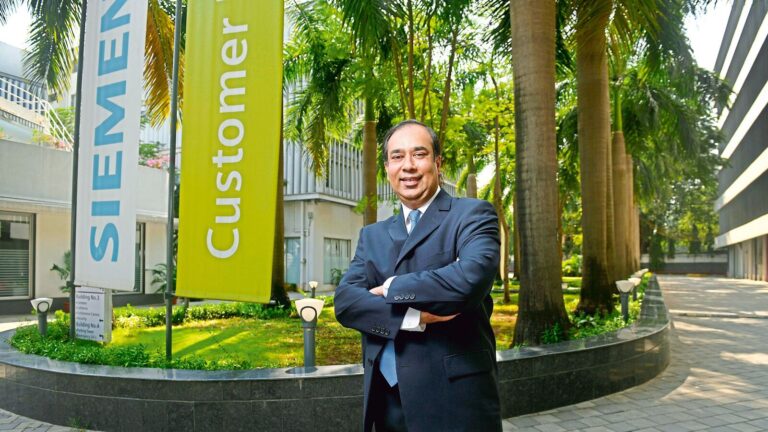“The demerger has allowed us to sharpen focus on our core businesses and drive shareholder value,” said Sunil Mathur, managing director and chief executive officer of Siemens, in an exclusive interview with Mint. “Each business is now moving independently and on track.”
Government-led capital expenditure remains a major growth driver for Siemens, with the company expecting private investment to follow as income tax measures announced in the budget and GST reforms begin to stimulate consumption.
“The government has done what it could to drive demand—now it depends on consumer behaviour and global conditions,” Mathur noted.
Despite global volatility, Siemens views India as a resilient and fast-growing market. Its three business verticals—Smart Infrastructure, Digital Industries, and Mobility—align closely with national priorities such as clean energy, modern manufacturing and urban mobility.
The company’s mobility division has emerged as a major growth engine, buoyed by marquee projects such as the ₹26,000-crore electric locomotive order and the high-speed rail signalling contract.
“These projects take our mobility business to the next level,” Mathur said. “We now have a complete presence across rolling stock, electrification, and signalling.”
Siemens is also expanding its propulsion and bogie manufacturing capacities in Aurangabad and Nashik and tapping into India’s rapidly growing electric vehicle (EV) charging market. “We’re already supplying chargers for commercial fleets, and that segment will expand rapidly,” he added.
Siemens holds a leading position in transport solutions, particularly in rail infrastructure. The company offers a full suite of products spanning signalling, electrification, and rolling stock components. It competes with global majors such as CRRC Corp. and Alstom, but its strength in automation keeps it among the top three players in rail and metro signalling, and among the top five in railway rolling stock.
Localization and global integration
Make in India remains central to Siemens’ expansion plan. The company operates around 25 factories across India, achieving up to 99% localization for the electric locomotive project.
The Aurangabad facility exports rail bogies to Europe, and nearly 20% of Indian production is now integrated into Siemens’ global supply chain.
“Localization isn’t a one-day job; it’s a journey involving engineering, design, and supplier development,” Mathur explained. “We’re continuously deepening that localization. India is emerging as a global manufacturing base for Siemens.”
Strategic acquisitions for new markets
While organic expansion remains the foundation, Siemens is actively pursuing inorganic opportunities that open new markets or add technology capabilities.
The 2021 acquisition of C&S Electric gave Siemens a strong foothold in India’s mid-market electrical equipment space. More recently, an acquisition in EV charging technology has added cost-effective solutions tailored to Indian conditions.
“Inorganic growth is a key part of our strategy—but we’re selective,” Mathur said. “An acquisition must bring us a new market, product, or cost-level technology.”
Digitalization and automation remain central to Siemens India’s transformation. The company is investing heavily in digital twins, AI (artificial intelligence), and industrial IoT (internet of things) to enhance manufacturing efficiency and integrate India’s plants into its global innovation ecosystem.
“Earlier, India was seen as a low-cost base,” Mathur said. “But technology is now the great equalizer. The future lies in combining India’s software strength with advanced manufacturing.”
“The current situation bodes well for infrastructure firms as raw material prices, particularly steel prices currently are subdued,” said A.S. Firoz, former chief economist at the steel ministry and a steel sector expert. “Besides, steel prices don’t really get impacted by global geo-political situation but have other issues impacting pricing that follows an extremely cyclical path. So, infrastructure sector companies, using steel as raw material, should do well without bothering about cost pressure and shrinking margins.”
Siemens also runs structured in-house learning and digital training initiatives to build next-generation capabilities. “Upskilling is essential, but technology will drive productivity leaps,” he added.
The company’s order book now exceeds ₹42,000 crore, driven by robust demand across energy, infrastructure, and mobility projects. With the government aiming to raise manufacturing’s share of GDP from 15% to 25%, Mathur believes Siemens is well positioned to power that transformation.
“Our technologies support India’s push for sustainable, intelligent infrastructure,” he said. “As India grows, Siemens grows with it. We’re deeply intertwined with the country’s industrial and infrastructure journey—and we’re here for the long run.”
Images are for reference only.Images and contents gathered automatic from google or 3rd party sources.All rights on the images and contents are with their legal original owners.
